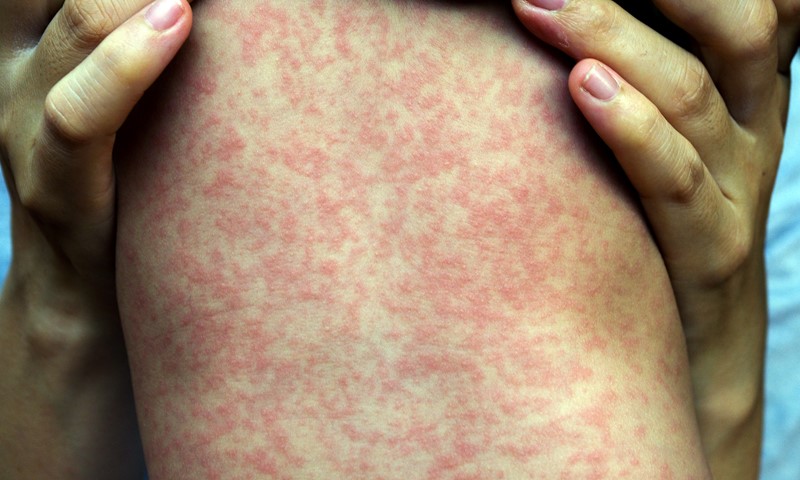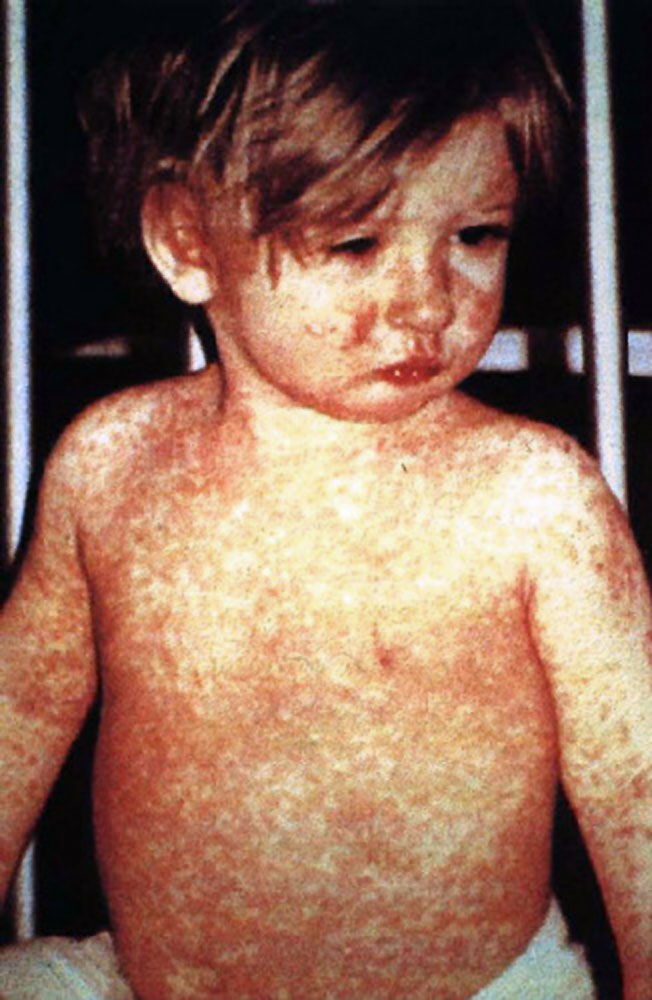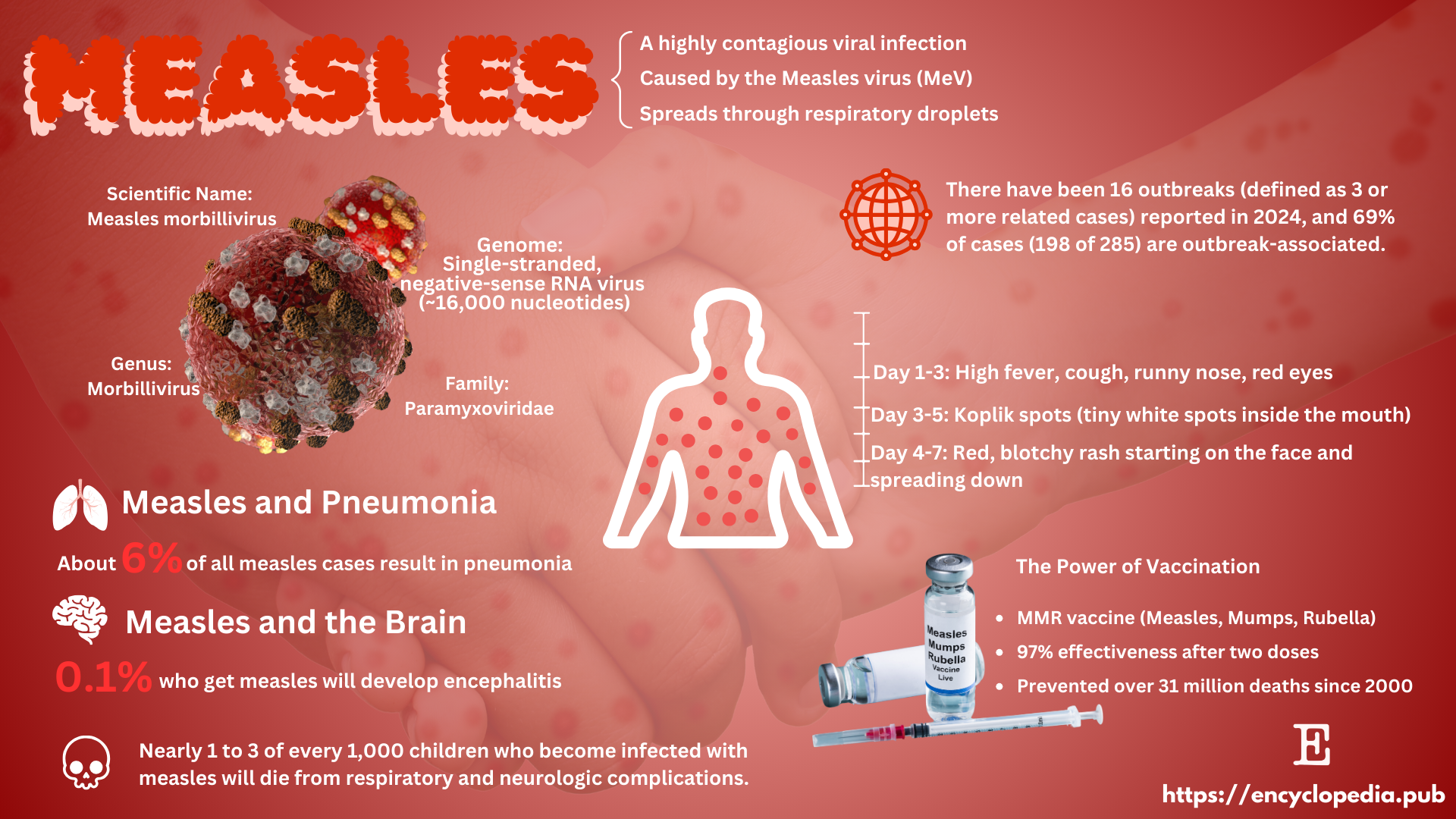
| Version | Summary | Created by | Modification | Content Size | Created at | Operation |
|---|---|---|---|---|---|---|
| 1 | Encyclopedia Editorial Office | -- | 977 | 2025-03-13 04:18:34 | | | |
| 2 | Catherine Yang | Meta information modification | 977 | 2025-03-19 02:06:27 | | |
Video Upload Options
Measles is a highly contagious viral infection caused by the measles virus (Morbillivirus genus, Paramyxoviridae family). It is characterized by fever, cough, coryza, conjunctivitis, and a distinctive maculopapular rash. Measles can lead to severe complications, including pneumonia, encephalitis, and death, particularly in unvaccinated populations.
1. Introduction
Measles, also known as rubeola, is a highly contagious viral infection that primarily affects children but can occur in individuals of any age. Historically, measles was a leading cause of childhood mortality worldwide, with an estimated 2.6 million deaths annually before the introduction of the vaccine in the 1960s [1]. Despite the availability of a safe and effective vaccine, measles remains a significant public health concern, particularly in regions with low vaccination coverage. Recent years have seen a resurgence of measles in some countries due to vaccine hesitancy, misinformation, and gaps in immunization programs [2].

Source: https://www.nhsinform.scot/illnesses-and-conditions/infections-and-poisoning/measles/
2. What is Measles?
Measles is caused by the measles virus, a single-stranded RNA virus belonging to the genus Morbillivirus in the Paramyxoviridae family [3]. The virus is highly contagious, with an estimated basic reproduction number (R0) of 12–18, meaning one infected individual can transmit the virus to 12–18 susceptible people in an unvaccinated population [4]. Measles is transmitted through respiratory droplets or airborne particles when an infected person coughs or sneezes. The virus can remain infectious in the air or on surfaces for up to two hours [5].
3. Symptoms and Clinical Presentation
The clinical course of measles typically begins with a prodromal phase lasting 2–4 days, characterized by high fever, cough, coryza (runny nose), and conjunctivitis (red eyes). A pathognomonic sign of measles is the appearance of Koplik’s spots, small white lesions on the buccal mucosa, which appear 1–2 days before the rash [6].
The hallmark of measles is a maculopapular rash that begins on the face and spreads downward to the trunk and extremities. The rash usually appears 3–5 days after the onset of fever and lasts for about 5–6 days [7]. Other symptoms may include malaise, anorexia, and diarrhea.
Complications of measles are more common in young children, pregnant women, and immunocompromised individuals. These include pneumonia (the most common cause of measles-related deaths), acute encephalitis, and subacute sclerosing panencephalitis (SSPE), a rare but fatal degenerative neurological condition that can develop years after the initial infection [8].

By CDC/NIP/Barbara Rice - http://phil.cdc.gov/phil/ (ID#: 132), Public Domain, https://commons.wikimedia.org/w/index.php?curid=210382
4. Transmission and Epidemiology
Measles is one of the most contagious diseases known, with transmission occurring through direct contact with infectious droplets or airborne spread. The virus can infect up to 90% of susceptible individuals exposed to an infected person [9].
Globally, measles remains a significant cause of morbidity and mortality, particularly in low- and middle-income countries. According to the World Health Organization (WHO), there were an estimated 128,000 measles deaths worldwide in 2021, mostly among children under five years of age [10]. Outbreaks continue to occur in regions with low vaccination coverage, including parts of Africa, Asia, and Europe [2].

5. Diagnosis
Measles is primarily diagnosed based on clinical presentation, particularly the presence of Koplik’s spots and the characteristic rash. Laboratory confirmation is often required for public health surveillance and outbreak control. Diagnostic methods include:
-
Serology: Detection of measles-specific IgM antibodies in serum, which typically appear 1–3 days after the onset of the rash [11].
-
Polymerase Chain Reaction (PCR): Detection of viral RNA in respiratory specimens, blood, or urine [12].
-
Viral Culture: Isolation of the virus in cell culture, though this method is less commonly used due to its complexity and time requirements [13].
6. Treatment and Management
There is no specific antiviral treatment for measles. Management focuses on supportive care to alleviate symptoms and prevent complications. Key measures include:
-
Hydration: Ensuring adequate fluid intake to prevent dehydration.
-
Fever management: Use of antipyretics such as acetaminophen or ibuprofen.
-
Vitamin A supplementation: The WHO recommends high-dose vitamin A for children with measles, as it has been shown to reduce the risk of complications and mortality [14].
-
Antibiotics: Used only if secondary bacterial infections, such as pneumonia or otitis media, occur [15].
7. Prevention
Vaccination is the most effective strategy for preventing measles. The measles vaccine is typically administered as part of the measles-mumps-rubella (MMR) vaccine, which provides long-lasting immunity in over 95% of recipients after two doses [16]. The first dose is usually given at 12–15 months of age, with a second dose at 4–6 years [17].
Herd immunity, achieved when a high percentage of the population is vaccinated, is critical for protecting individuals who cannot be vaccinated, such as infants and immunocompromised individuals. The WHO recommends a vaccination coverage rate of at least 95% to prevent outbreaks [18].
In cases of known exposure, post-exposure prophylaxis with the MMR vaccine or immune globulin may be recommended for susceptible individuals to prevent or mitigate the disease [19].
8. Measles and Vaccination Controversies
The development of the measles vaccine in the 1960s marked a turning point in the fight against the disease. However, vaccination efforts have been hampered by misinformation and vaccine hesitancy. A now-debunked study published in 1998 falsely linked the MMR vaccine to autism, leading to a decline in vaccination rates in some countries [20]. Subsequent research has thoroughly discredited this claim, and numerous studies have confirmed the safety and efficacy of the MMR vaccine [21].
9. Global Efforts and Challenges
The WHO and other global health organizations have set ambitious goals for measles elimination. The Measles & Rubella Initiative, launched in 2001, has helped vaccinate over 2.9 billion children and prevent an estimated 31.7 million deaths [22]. However, challenges remain, including vaccine access in remote areas, logistical barriers, and the spread of vaccine misinformation [23].
10. Conclusion
Measles is a preventable disease that continues to pose a significant threat to global health, particularly in under-vaccinated populations. Vaccination remains the most effective tool for controlling measles and preventing outbreaks. Public health efforts must address vaccine hesitancy, improve access to immunization services, and strengthen surveillance systems to achieve the goal of global measles elimination.
References
- Perry, R. T., & Halsey, N. A. (2004). The clinical significance of measles: A review. Journal of Infectious Diseases, 189(Supplement_1), S4–S16. https://doi.org/10.1086/377712
- Patel, M. K., Goodson, J. L., Alexander, J. P., et al. (2020). Progress toward regional measles elimination — worldwide, 2000–2019. Morbidity and Mortality Weekly Report (MMWR), 69(45), 1700–1705. https://doi.org/10.15585/mmwr.mm6945a6
- Griffin, D. E. (2013). Measles virus. In Fields Virology (6th ed., pp. 1042–1069). Lippincott Williams & Wilkins.
- Guerra, F. M., Bolotin, S., Lim, G., et al. (2017). The basic reproduction number (R0) of measles: A systematic review. The Lancet Infectious Diseases, 17(12), e420–e428. https://doi.org/10.1016/S1473-3099(17)30307-9
- Laksono, B. M., de Vries, R. D., McQuaid, S., et al. (2016). Measles virus host invasion and pathogenesis. Viruses, 8(8), 210. https://doi.org/10.3390/v8080210
- erry, R. T., & Halsey, N. A. (2004). The clinical significance of measles: A review. Journal of Infectious Diseases, 189(Supplement_1), S4–S16. https://doi.org/10.1086/377712
- Moss, W. J. (2017). Measles. The Lancet, 390(10111), 2490–2502. https://doi.org/10.1016/S0140-6736(17)31463-0
- Wendorf, K. A., Winter, K., Zipprich, J., et al. (2017). Subacute sclerosing panencephalitis: The devastating measles complication that might be more common than previously estimated. Clinical Infectious Diseases, 65(2), 226–232. https://doi.org/10.1093/cid/cix302
- Strebel, P. M., Papania, M. J., Fiebelkorn, A. P., & Halsey, N. A. (2013). Measles vaccines. In Vaccines (6th ed., pp. 352–387). Elsevier.
- World Health Organization (WHO). (2022). Measles. Retrieved from https://www.who.int/news-room/fact-sheets/detail/measles
- Helfand, R. F., Heath, J. L., Anderson, L. J., et al. (1997). Diagnosis of measles with an IgM capture EIA: The optimal timing of specimen collection after rash onset. Journal of Infectious Diseases, 175(1), 195–199. https://doi.org/10.1093/infdis/175.1.195
- Rota, P. A., Brown, K., Mankertz, A., et al. (2011). Global distribution of measles genotypes and measles molecular epidemiology. Journal of Infectious Diseases, 204(Suppl 1), S514–S523. https://doi.org/10.1093/infdis/jir118
- Bellini, W. J., & Rota, P. A. (1998). Genetic diversity of wild-type measles viruses: Implications for global measles elimination programs. Emerging Infectious Diseases, 4(1), 29–35. https://doi.org/10.3201/eid0401.980105
- World Health Organization (WHO). (2017). Vitamin A supplementation in measles. Retrieved from https://www.who.int/elena/titles/vitamina_measles/en/
- Kabra, S. K., & Lodha, R. (2013). Antibiotics for preventing complications in children with measles. Cochrane Database of Systematic Reviews, (8), CD001477. https://doi.org/10.1002/14651858.CD001477.pub4
- McLean, H. Q., Fiebelkorn, A. P., Temte, J. L., & Wallace, G. S. (2013). Prevention of measles, rubella, congenital rubella syndrome, and mumps, 2013: Summary recommendations of the Advisory Committee on Immunization Practices (ACIP). Morbidity and Mortality Weekly Report (MMWR), 62(RR04), 1–34.
- Centers for Disease Control and Prevention (CDC). (2021). Measles, mumps, and rubella (MMR) vaccination: What everyone should know. Retrieved from https://www.cdc.gov/vaccines/vpd/mmr/public/index.html
- World Health Organization (WHO). (2017). Measles vaccines: WHO position paper. Weekly Epidemiological Record, 92(17), 205–228.
- Fiebelkorn, A. P., Redd, S. B., Gallagher, K., et al. (2014). Measles in the United States during the postelimination era. Journal of Infectious Diseases, 210(2), 246–252. https://doi.org/10.1093/infdis/jiu105
- Wakefield, A. J., Murch, S. H., Anthony, A., et al. (1998). Retracted: Ileal-lymphoid-nodular hyperplasia, non-specific colitis, and pervasive developmental disorder in children. The Lancet, 351(9103), 637–641. https://doi.org/10.1016/S0140-6736(97)11096-0
- Taylor, L. E., Swerdfeger, A. L., & Eslick, G. D. (2014). Vaccines are not associated with autism: An evidence-based meta-analysis of case-control and cohort studies. Vaccine, 32(29), 3623–3629. https://doi.org/10.1016/j.vaccine.2014.04.085
- Measles & Rubella Initiative. (2022). About us. Retrieved from https://measlesrubellainitiative.org/about-us/
- Orenstein, W. A., & Seib, K. (2014). Mounting a good offense against measles. New England Journal of Medicine, 371(18), 1661–1663. https://doi.org/10.1056/NEJMp1408696




